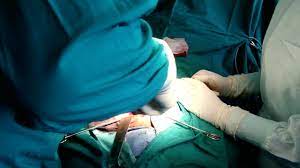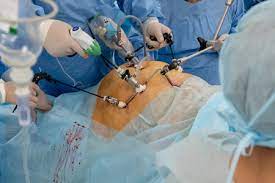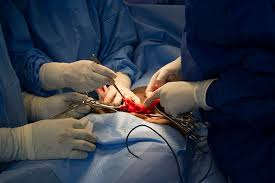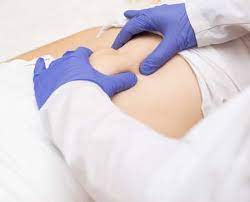A hernia is a tear in your muscle or tissue that causes a portion of your internal organs to protrude. However, Hernias symptoms in men and women may vary. A protrusion of an internal organ or your intestines might be the cause.
Depending on the location and size of the hernia, you may be able to see it. Bending over or moving large things, for example, might aggravate the disease.
In women, inguinal hernias are more likely to become an emergency. Women are also more likely than males to experience difficulties.
As a result, after a diagnosis, we usually prescribe surgical correction. Hernias are most commonly found in the groin.
Hernias can also occur around the belly button, through a surgical scar, in the diaphragm.
There are two surgical treatments for inguinal hernias

- Minimally invasive surgery
- Minimally invasive robotic surgery.
With minimally invasive surgery, patients are back to their regular activity within two weeks.
Hernias in the abdomen

However, Repair is suggested for most abdominal hernias in both men and women.
The only exception is if you have risk factors for complications such as obesity or poorly managed diabetes.
It is also preferable to treat those conditions before undergoing surgery.
See also World Tuberculosis Day 2022: Understanding Tuberculosis Symptoms, Causes
Some patients also experience no symptoms and may elect to postpone surgery after discussing the risks and benefits with their physician.
Because ventral hernias come in all shapes and sizes, surgical options and recovery times vary greatly.
A minor umbilical or incisional hernia may frequently be corrected as an outpatient procedure.
Repairing more complex hernias, on the other hand, may necessitate from one to five-day hospital stay.
What exactly causes hernia

The various forms of hernias can be caused by a variety of factors.
A hernia typically begins with pressure on an organ or your intestines.
When this pressure occurs in the same region as a weakening muscle or tissue, a hernia arises.
Some people are born with weak muscles or underdeveloped tissue. Most people, however, get hernias as their bodies age and their muscles weaken.
Certain motions and behaviours can potentially cause a hernia or aggravate an existing one:
- Picking up heavy items (especially lifting them in the wrong way and with weak muscles)
- Repetitive use of the same muscle
- Coughing, sneezing, diarrhoea, or constipation can all cause squeezing.
- Being overweight or eating poorly
- Tobacco use
What are the different types of hernias
The six common types of hernias are umbilical, epigastric, ventral, obturator and femoral hernias.
Femoral Hernias
Femoral hernias are more prevalent in women and arise when a portion of the intestine protrudes through the femoral canal and protrudes at the top of the thigh.
The primary blood veins that feed the legs flow through the femoral canal.
Epigastric hernias
Epigastric hernias are fat or intestinal protrusions through the abdominal wall between the navel and the breastbone.
Inguinal Hernias
When tissue (such as fat or intestines) protrudes through a weakness in the abdominal cavity around the groin, this is also referred to as an inguinal hernia.
The herniated portion may then pass through the hole and into the groin or scrotum.
Umbilical Hernias
Umbilical hernias arise when the abdominal wall at the site of the umbilical cord is weakened (belly button).
It is the second most frequent form of hernia in adults, although women are more prone to get them because pregnancy is an evident “risk factor” for umbilical hernias.
These hernias may frequently be minimized manually or treated surgically.
Ventral hernias
A ventral hernia, also known as an incisional hernia, arises when scar tissue weakens the abdominal wall following surgical treatment.
These hernias can also appear anyplace on the abdomen where a scar exists, such as a midline or lateral margin.
Hernias of the obturator
An obturator hernia also arises when a portion of the intestine goes through the opening between the front pelvic bones.
Hiatal Hernia
A hiatal hernia is an interior hernia that is not apparent from the outside.
The top section of the stomach also protrudes through a hole (hiatus) in the diaphragm, normally occupied by the oesophagus.
Moreover, It has also been linked to gastroesophageal reflux disease.
Symptoms of Hernia
Are you wondering if the pain in your stomach or groin is caused by a hernia?
In women, groin hernias are substantially less prevalent. Hernias can be uncomfortable and do not go away on their own.
Women’s Hernia Symptoms

- Sharp or aching pain
- Sensation of burning
- A bulge at the location of the hernia, however, may not be evident with a groin hernia.
- Discomfort that worsens with physical exercise
Men’s Hernia Symptoms
- A visible or palpable protrusion
- Aching in the affected region
- Sense of pressure
- Scrotum pulling feeling around the testicles
- Pain that intensifies when doing tasks that put pressure on the region, such as hard lifting, pushing, and straining.
Early Hernia symptoms
- Painful protrusion that does not shrink when you lie down.
- Pain is becoming worse.
- Vomiting and/or nausea
- Having a bowel movement is difficult.
- Bloating Rapid heartbeat
- Fever
